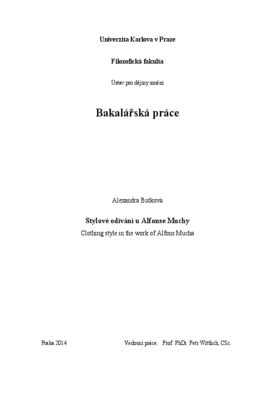Stylové odívání u Alfonse Muchy
Clothing style in the work of Alfons Mucha
bakalářská práce (OBHÁJENO)

Zobrazit/
Trvalý odkaz
http://hdl.handle.net/20.500.11956/69933Identifikátory
SIS: 135926
Katalog UK: 990018529080106986
Kolekce
- Kvalifikační práce [24991]
Autor
Vedoucí práce
Oponent práce
Rakušanová, Marie
Fakulta / součást
Filozofická fakulta
Obor
Dějiny umění
Katedra / ústav / klinika
Ústav pro dějiny umění
Datum obhajoby
10. 9. 2014
Nakladatel
Univerzita Karlova, Filozofická fakultaJazyk
Čeština
Známka
Výborně
Klíčová slova (česky)
Alfons Mucha, secese, odívání, divadelní kostým, šperkKlíčová slova (anglicky)
Alfons Mucha, Art Nouveau, fashion, theatre costume, jewelleryCílem této práce je prozkoumat vztah Alfonse Muchy a soudobé módy a šperku a pokusit se popsat způsob odění žen v jeho reklamní grafické tvorbě a najít jeho možné zdroje inspirace. Práce je rozdělena na čtyři základní části. První se zabývá Muchovým vztahem k divadlu a pokouší se určit jeho podíl na kostýmním výtvarnictví. Druhá část se zabývá jeho reklamní grafickou tvorbou a má za cíl definovat různé způsoby odění jeho alegorických ženských postav a najít jejich zdroje inspirace. Cílem třetí části je popsat fenomén reformních snah v oblasti ženského oděvu a zjistit, jaký byl vztah Alfonse Muchy k soudobé módě. Poslední část se zabývá Muchovými návrhy na šperky. Práce vychází předně jednak z grafik Alfonse Muchy a dochovaných návrhů na šperky a divadelní kostýmy, tak z dobových literárních pramenů.
The aim of this thesis is to examine the relation between Alfons Mucha and contemporary fashion and jewellery and to try to describe the clothing style in his graphic advertisements and to find sources of his inspiration. The thesis is divided into four main sections. The first one talks about Mucha's relationship with the theatre and tries to determine his involvement in theatrical costume design. The second part concerns his graphic advertisements and aims to define different types of clothing of his allegorical women figures and to find sources of their inspiration. The goal of the third part is to characterize the phenomenon of attempts at reforming women's costume and to take a look at the relationship between Alfons Mucha and contemporary fashion. The last part deals with Mucha's jewellery designs. This work is based primarily on Alfons Mucha's graphics and surviving jewellery and costume designs and on literary sources from that period.
